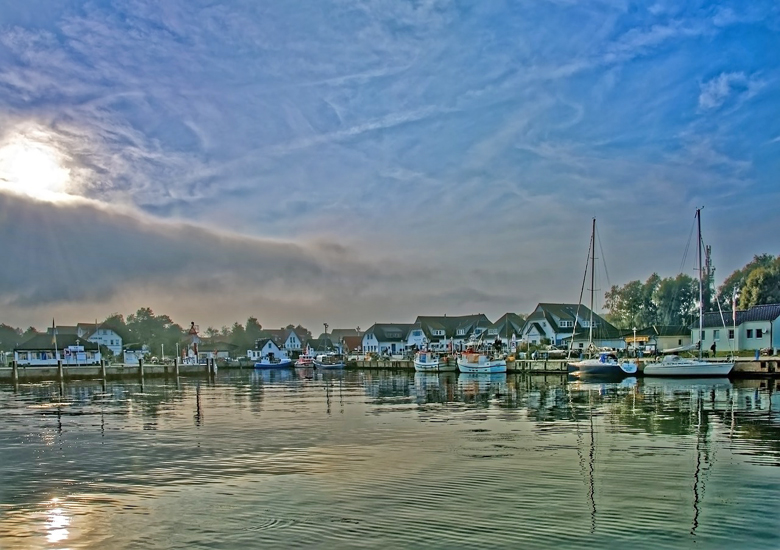Hiddensee is a car-free island in the Baltic Sea, located west of Germany’s largest island, Rugen, on the German coast.
The island has about 1,300 inhabitants. It was a holiday destination for East German tourists during German Democratic Republic (GDR) times, and continues to attract tourists today. It is the location of the University of Greifswald’s ornithological station. Gerhart Hauptmann and Walter Felsenstein are buried there.
Access : Coordinates: 54.54, 13.092778 / Private motor vehicles are banned throughout the entire island. For public services and agricultural purposes only a few motorized vehicles are permitted. As a result, the island is virtually car-free. Some of the permitted vehicles are equipped with electric propulsion.
The majority of the public transport and part of the goods traffic is provided using horse-drawn carriages. A public bus service operated by the Rugener Personennahverkehr (RPNV) runs between the villages of Grieben, Kloster, Vitte and Neuendorf. The island may be reached from Stralsund as well as Schaprode on Rugen with passenger ferries of the Reederei Hiddensee, which call at Kloster, Vitte and Neuendorf. In the summer season there are additional services to Ralswiek, Breege, Wiek and Zingst. In addition, there are water taxi links with the mainland and the island of Rugen.
Highlights :
- Dornbusch Lighthouse : In the north of the island, on the Schluckswiek in the so-called Hochland (“highlands”) of Hiddensee, stands the symbol of the island, the Hiddensee Lighthouse. 102 steps climb the tower that has been open to the public since 1994.
- The Gerhart Hauptmann House : In 1930 Gerhart Hauptmann bought the former Haus Seedorn on Hiddensee. Today it houses a museum and is a venue for cultural events.
- The Hiddensee Island Church (Inselkirche Hiddensee) in Kloster is part of an old monastery. It was consecrated in 1332 and served for centuries as the parish church for the island’s inhabitants. Today the island church is the seat of the Evangelical parish of Hiddensee.
- Lietzenburg : The Lietzenburg is an Art Nouveau villa, which the artist Oskar Kruse had built in the years 1904/1905. It is a brick building with a natural stone base on a hill near the Dornbusch.
- Hiddensee Local History Museum : The Hiddensee Local History Museum (Heimatmuseum Hiddensee) is a modest plastered building in Kloster. It has a permanent exhibition about the island’s history with about 450 exhibits, documents, about 2,500 photographs, postcards and slides as well as a comprehensive library. Several works of well known representatives of the artists’ colony on Hiddensee are also in the museum’s collection. In the building there is also and exhibition about the abbey excavations in 2008 and the special exhibition celebrated the 100th anniversary of Eggert Gustavs .
- Fishing village Vitte : an UNESCO World Heritage list since 1973.
- The Hiddensee National Park House (Nationalparkhaus Hiddensee) was opened in 1998. The house, located in the north of Vitte, is a thatched building with a trapezoidal ground plan. It contains a permanent exhibition about the West Pomeranian Lagoon Area National Park with special emphasis on Hiddensee.
- Asta Nielsen House : The round building, named after the Danish word for carousel, is also called Karusel, and was occupied by Asta Nielsen.
- Blaue Scheune : The Blaue Scheune was originally a Low German hall house from the early 19th century. It currently houses an art gallery with works that belonged to the painter, Gunter Fink (1913-2000).
- Henni Lehmann House : The Landhaus Lehmann was used from 1907 to 1937 as a summer residence for the family of Henni Lehmann. It was designed by Schwerin architect, Paul Ehmig . After that it was modified and was used until 1991 as the village hall of Vitte. Since 5 June 2000 the house has been officially named the Henni-Lehmann-Haus and is used for events and exhibitions as well as the local library.
- Neuendorf – Leuchtfeuer Gellen : The 12.30 metre-high structure (focal height 10 metres), a sector light beacon (Leitfeuer and Quermarkenfeuer), is located south of Neuendorf on the northern boundary of the Gellen.
Go next : Greifswald / Heringsdorf / Schaprode / Stralsund / Breege-Juliusruh / Rugen / Zingst

